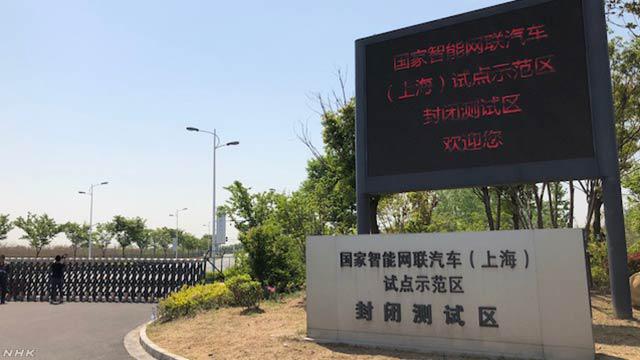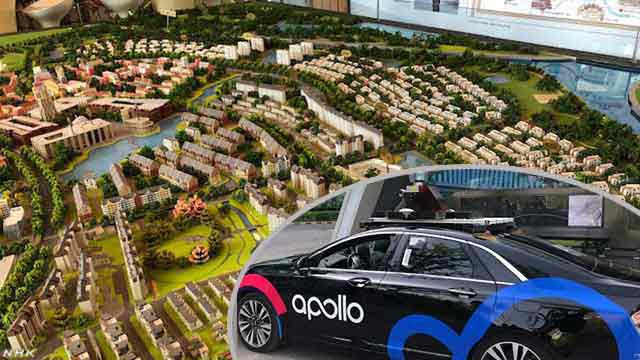China designates 6 cities as testing grounds
In China, self-driving and other next-generation vehicles are referred to as Intelligent Connected Vehicles or ICVs. They include AI-driven or Internet-connected vehicles.
The government has designated 6 major cities as proving grounds for ICVs: Beijing, Shanghai, Chongqing, Hangzhou in Zhejiang Province, Changchun in Jilin Province, and Wuhan in Hubei Province.
Plans to integrate self-driving technologies and services with the urban system are being rolled out. In Shanghai's Anting district, about 30 kilometers northwest of the city center, a project was launched in June 2015.
What started with testing on a 5 square-kilometer course is scheduled to be upgraded in 2019 to test-driving on public roads over 100 square-kilometers. By the end of 2020, officials aim to put driverless vehicles into operation between Anting and Hongqiao International Airport.

Caution regarding overdependence on vehicles
There are 2 types of self-driving technologies. The stand-alone type uses sensors and cameras mounted on the vehicle to detect and avoid pedestrians and obstacles. This enables self-sufficient navigation.
The other is infrastructure-enabled autonomy. It uses information transmitted from signs, traffic lights and other infrastructure. Safety is thus maintained through the integrated operation of vehicles and traffic.
IT giant Google and ride-hailing company Uber are among those testing the former type, while China is pursuing the latter.
Professor Xiong Lu of Tongji University, who is involved in the Chinese plan, argues that current self-driving technologies are not capable of dealing with complex situations on the road. He says vehicles alone can't solve all the issues, and calls for an approach combining autonomous vehicles with the traffic system.
The professor maintains this approach works better in China, where demand for urban development is high.
He also says the system allows for the efficient control of traffic speed by providing vehicles with a range of information. That includes not only visual cues such as the color of traffic lights, but also other data such as the timing of light changes and traffic congestion. He says this could help ease congestion and save energy -- 2 big problems for the country.
Work steadily underway to create "driverless" city
A unique program is underway in Anting, a municipality in Shanghai. Authorities have built a 2.5-kilometer course in a park where people can go for a test drive. Self-driving vehicles cruise at speeds of about 30 kilometers per hour alongside pedestrians and cyclists.
Officials say nearly 4,000 people have tried out the technology in just half a year.
A new housing project for about 10,000 people is underway in the vicinity. Officials at the real estate developer say they are considering operating driverless buses and offering an automatic parking service there.
Bettering communication
Another feature of the driverless city initiative is to improve coordination between the auto and IT industries.
Anting was home to many companies in the automotive business when the government chose it to host a new site named the Innovation Park in 2012.
There are now more than 30 tenants from both inside and outside the country, including major automakers, Chinese IT giant Alibaba and Israel's Mobil Eye -- a company that creates image-recognition technology.
About 230 million dollars have been invested in the park, with further expansion planned.
Tax and other incentives are in place for tenants. The park's public relations official says that by providing a platform that enables communication among the tenants, they are able to develop self-driving technologies that could be used on a commercial basis.
Chinese venture companies and foreign automotive firms are noting the benefits of conducting research and working together at the park.
But the grand project is lagging behind schedule. Test driving on a public road only began in March on a short track of just 5.6 kilometers.

Still, Rong Wenwei, the chairman of the state-run Shanghai International Automobile City Group, a developer of the initiative stresses the merits of the project. He says if they come with a successful urban development model, it would be a waste not to share it with the world. He believes the Chinese government can play a leading role in providing a major framework for industrial development. Despite current struggles, he seems to be confident that China can export infrastructure-coordinated self-driving systems once they are established.
"China's Google" also in the game
Baidu, often referred to as China's Google, is also working on the project. The firm has begun developing AI for self-driving vehicles, collaborating with automakers around the world.
The company is testing driverless vehicles in the precinct of its Beijing headquarters.
It's taking part in the development project of the Xiongan New Area in Hebei Province, about 100 kilometers south of central Beijing. The massive project spans an area of 2,000 square kilometers. And investment is estimated to exceed $900 billion.
Helen Pan, who oversees the development of self-driving technology for the project, stressed that it can help to reduce deaths on the road.
The strategy is to create a city free of traffic accidents from the ground up by developing both self-driving vehicles and a traffic system that accommodate them.
Involvement of Japanese firms
Japanese companies are playing a role in the progress in China.
Among them is Renesas Electronics. The major semiconductor manufacturer enjoys a top global share for products that control car accelerators and brakes.
Self-driving vehicles require semiconductors that can control not only driving functions, but also recognize the surroundings and make judgments for safe navigation. Baidu leads in the development of AI, but lacks the capacity to manufacture the body and parts of the vehicle. That's why it teamed up with Renesas last year. Renesas is hoping to expand its involvement in the project, and is aiming to develop products that can be used for infrastructure.
It remains to be seen how much traction the Chinese-style solution will gain in the highly competitive field of self-driving technology. It could significantly recreate the landscape of the automobile, semiconductor, and many other sectors.
